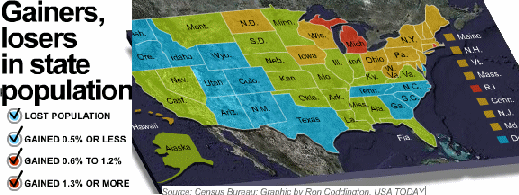If brand management is increasingly about customer input, feedback and how they share their experiences, does that mean more investment in “after the transaction” is required to differentiate?
Pricing
So I was doing a little bit of travel over the holidays and got to see a good bit of the back roads country and survey roadside advertising. The quality, product mix and “vacancy rates” appeared to have changed from what I historically remember. Although I will say that promotional messaging for empty billboards is getting much better. The other interesting thing is the use of “shared space” appears to be up for billboards….
Billboards may be a bellwether for the state of the economy and represent a great part of the cultural landscape which I like to appreciate. I originally wrote myself a note on this topic last week, but was reminded of the concept by Vaguery on twitter, who in real life is Bill and blogs over @ Notional Slurry. Economic trends and perceptions of the economy impact individual, local and regional buying behaviors and how marketers appeal to buyers.
Vaguery’s tweet of “…considering the likelihood of any Michigander doing real five-figure cookery” seemed to align with billboards, data and articles I’ve been reading/seeing, such as the USA Today piece I read over my free continental breakfast the other day. So things are changing – spend patterns, the movement of people and general open market activities.

The USA article spoke of the current housing woes and how they impact population movement. “Michigan hard hit by cutbacks in the auto industry and other manufacturing sectors” has seen population decline and housing value declines ahead of the rest of the nation. This was unscientifically verified as I drove around and saw more for sale signs than I think I have ever seen.
At the most basic level, demographic changes impact market dynamics – specifically how people market and what they market. With a more granular look at the population shift, by state, it becomes evident that Michigan and RI are seeing a different level of change than other markets.

With the change in the economy and population, the roadside marketing landscape has changed as well since general investment patterns change from all key constituents segments – government, national brands and local SMBs. This change appears to be visible in the current billboard mix being mainly casino oriented in Detroit – no longer automotive/manufacturing innovation related. The overall billboard content also appears to be on a different level of creative quality as well, not just the type of advertiser. I was able to find the following billboard just outside Lansing in Portland, Michigan which is an example of the changing billboard landscape throughout Michigan.

I’m glad I’m not in billboard advertising with a weakening dollar, tempered consumer confidence and the apparent need for cheap pepper spray as a stocking stuffer.
So I spent a good deal of time thinking about value this weekend for a couple of reasons:
1. I had to spend way too much time in a vet hospital for my dog panic and cost/benefit never really entered my mind, but I did do some quick budget math out of financial diligence – couldn’t help it.
2. I need to find Guitar hero and I can’t. But I did find out some guy paid $10,000 for one, not me though – cost/benefit entered my mind on this one.
3. The dollar menu at McDonald’s – how are those items only worth $1? I mean I like double cheeseburgers.
So I thought about it and realized that value is in the eye of the beholder or rather the coveter – but perhaps the marketer as well. Not sure if value is ever the same or within banded limits at any point in time and this is the most confusing thing about value. Value is about the buyer, so as a marketer and product manager know how can you optimize the value or perceived value of your product. Effective product placement can significantly change the value of something – right channel, the right package, the right promotion…. Often the value of something is marketed and delivered to market based on a plan, so perhaps a double cheeseburger is only worth a $1, if [tag]share of wallet[/tag] is a key careabout. Value is situational for both the buyer and seller. So I’ve cut in a general overview from Wikipedia on Value for consideration:
The economic value of something is how much a desired object or condition is worth relative to other objects or conditions…
In [tag]neoclassical economics[/tag], the value of an object or service is often seen as nothing but the price it would bring in an open and competitive market. This is determined primarily by the demand for the object relative to supply. Many neoclassical economic theories equate the value of a commodity with its price, whether the market is competitive or not. As such, everything is seen as a commodity and if there is no market to set a price then there is no economic value.
In classical economics, the value of an object or condition is the amount of discomfort/labor saved through the consumption or use of an object or condition (Labor Theory of Value). Though exchange value is recognized, [tag]economic value[/tag] is not dependent on the existence of a market and price and value are not seen as equal.
In this tradition, to [tag]Steve Keen[/tag] “value” refers to “the innate worth of a commodity, which determines the normal (‘equilibrium’) ratio at which two commodities exchange.” To Keen and the tradition of David Ricardo, this corresponds to the classical concept of long-run cost-determined prices, what Adam Smith called “[tag]natural prices[/tag]” and [tag]Karl Marx[/tag] called “[tag]prices of production[/tag].” It is part of a cost-of-production theory of value and price. Ricardo, but not Keen, used a “labor theory of price” in which a commodity’s “innate worth” was the amount of labor needed to produce it.
In another classical tradition, [tag]Marx[/tag] distinguished between the “[tag]value in use[/tag]” (use-value, what a commodity provides to its buyer), “value” (the socially-necessary labour time it embodies), and “exchange value” (how much labor-time the sale of the commodity can claim, Smith’s “[tag]labor commanded[/tag]” value). By most interpretations of his labor theory of value, Marx, like Ricardo, developed a “[tag]labor theory of price[/tag]” where the point of analyzing value was to allow the calculation of relative prices. …
Value in the most basic sense can be referred to as “Real Value” or “Actual Value.” This is the measure of worth that is based purely on the utility derived from the consumption of a product or service. Utility derived value allows products or services to be measure on outcome instead of demand or supply theories that have the inherent ability to be manipulated.
Alas, value is subjective and may or may not have any relationship to production effort ([tag]cost plus[/tag]) or value in use. The ever changing marketplace makes understanding your products value an ongoing and continuous thread of activity.
Sounds like this value thing is a continuous loop caused by an if-then-goto statement in the business plan.
So I challenged myself to come up with a new slide theme and I unreasonably constrained myself to the “RQ” which I had already created as a category for my [tag]slideshare[/tag] quote [tag]project[/tag].
I just get a little nervous when I convert a category to a tag in [tag]wordpress[/tag].


